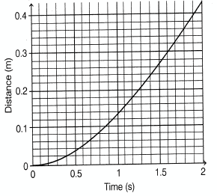HARD
Earn 100
Here we know that for turbulent flow, we need a certain limit of Reynolds number. So, what is Reynold's number?
(a)Ratio of viscous forces to inertial force.
(b)Ratio of inertial forces to viscous forces
(c)Ratio of inertial force to shear stress
(d)Ratio of shear stress to viscous force
50% studentsanswered this correctly
Important Questions on Properties of Matter
EASY
EASY
A flat plate of area is separated form a large plate by a layer of Glycerine thick. If the coefficient of viscosity of Glycerine is poise, the force required to keep the plate moving with a velocity of is
EASY
HARD
MEDIUM
EASY
EASY
MEDIUM

HARD
A steel ball is dropped in a viscous liquid. The distance of the steel ball from the top of the liquid is shown below. The terminal velocity of the ball is closest to

MEDIUM
MEDIUM
EASY
MEDIUM
MEDIUM
MEDIUM
(Take )
EASY
MEDIUM
EASY
HARD
MEDIUM

